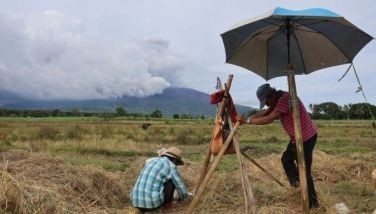Scientists allay fears of collision between Earth and asteroid
MALOLOS CITY, Philippines – Filipino scientists yesterday allayed fears of a possible collision between the Earth and a 130,000-ton asteroid, which is set to hover within an uncomfortable proximity from the planet in the early hours of Saturday.
“Nothing to worry about, it will miss us,†said Norman Marigza, an astrophysicist at the Rizal Technological University (RTU).
Marigza was talking about the 2012 DA14, an Apollo-class asteroid measuring 40 meters in diameter. He said even as the Earth’s gravitational pull would affect the asteroid’s orbit, calculations are that it would miss the planet.
The asteroid has been orbiting the sun, and closely approaches Earth twice every six months. It was discovered a year ago by the Observatorio Astronomico de La Sagra in Spain.
Custer Deocaris, an astrobiology professor at RTU, said the 2012 DA14 would be hovering 22,000 kilometers from the Earth.
“This is the closest asteroid fly-by in recorded history,†said Deocaris, noting the distance from Earth is even closer than that of satellites in geostationary orbits.
He said depending on sky conditions the asteroid might be barely visible around 3 a.m. However, residents of mega cities like Manila might not be able to enjoy the rare sight due to pollution and smog.
Deocaris said despite its proximity, 2012 DA14 would not hit Earth during this pass. He said this intimate encounter coincides with the observance of the National Astronomy Week (NAW) from Feb. 17 to 23.
“We need to raise awareness on such breathtaking issues in astronomy, which plays a crucial role in inspiring young people. It works as a tool in bringing our youth to science,†said Deocaris.
For his part, Christopher Louie Lu, of the Astronomical League of the Philippines (ALP), said the asteroid pass-by is only one of the many astronomical events set to happen this year. He said comets PANSTARR and ISON would pass by the Earth this March and November, respectively.
Filipino astronomers and planetary scientists are set to discuss the two comets in separate events at the RTU and Manila Planetarium. They will also tackle the future of the Philippine Space Agency (PSA) following the historic launching of the space movement last December.
Regarding a possible worst-case scenario, scientists said it’s better to refer to the past.
Deocaris cited an asteroid smaller than 2012 DA14 that wiped out a forest over thrice the size of Manila, in Tunguska, Siberia in 1908, and the one that hit Chicxulub, Mexico some 65.5 million years ago that brought 75 percent of life to extinction.
“It might sound pretty much like sci-fi, but scientists at NASA working with the Wide-field Infrared Survey Explorer (WISE) have tracked virtually all potentially hazardous asteroids (PHA) in orbits that come within eight million kilometers of our planet. These PHAs are large enough to be globally and regionally destructive if they were to hit us,†he said.
The scientists added that there are over 4,700 destructive asteroids with diameters larger than 100 meters floating in space. The possibility has helped spark discussion of asteroid deflection strategies.
“Now we know the orbits of these killer asteroids, we can launch ‘gravity tractors’ that will slowly nudge these orbits. For this asteroid deflection mission to succeed, we also need data on the composition and structure of the asteroid,†he said.
- Latest
- Trending


























